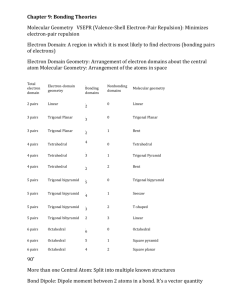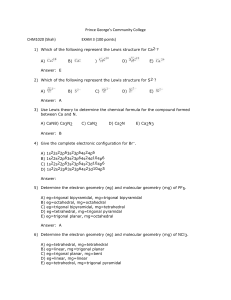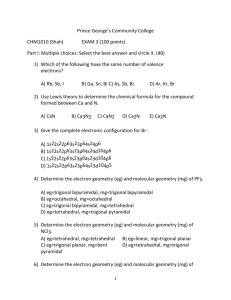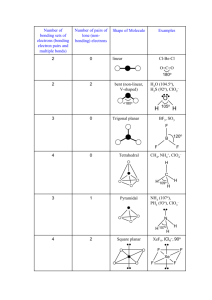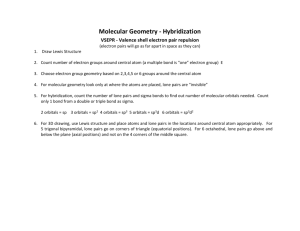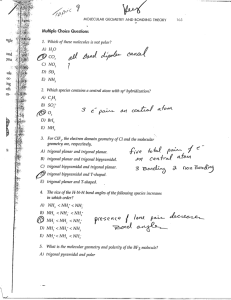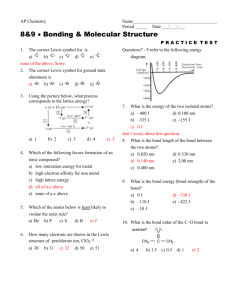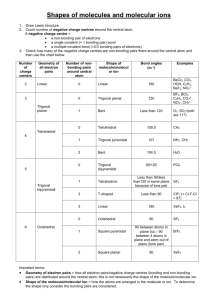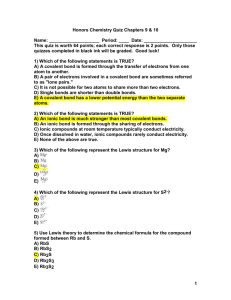9.1 A seesaw molecular geometry comes from removing an
advertisement
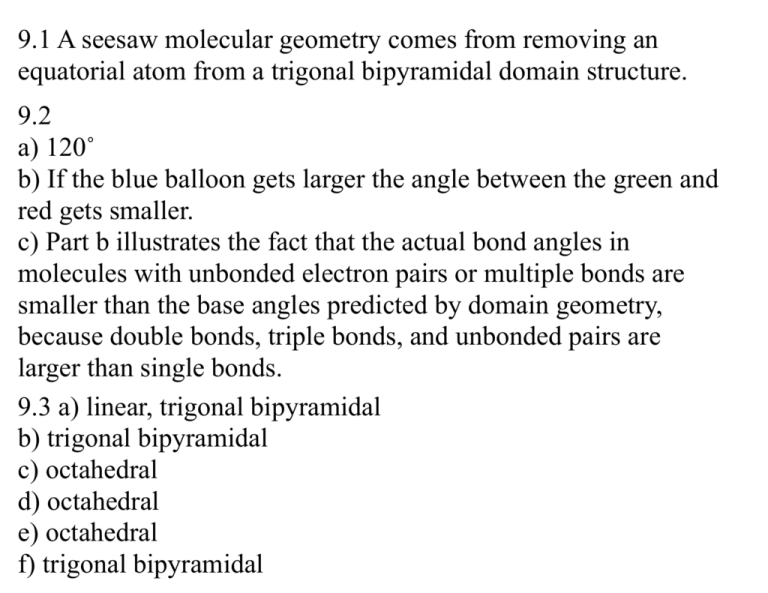
9.1 A seesaw molecular geometry comes from removing an equatorial atom from a trigonal bipyramidal domain structure. 9.2 a) 120˚ b) If the blue balloon gets larger the angle between the green and red gets smaller. c) Part b illustrates the fact that the actual bond angles in molecules with unbonded electron pairs or multiple bonds are smaller than the base angles predicted by domain geometry, because double bonds, triple bonds, and unbonded pairs are larger than single bonds. 9.3 a) linear, trigonal bipyramidal b) trigonal bipyramidal c) octahedral d) octahedral e) octahedral f) trigonal bipyramidal 9.4 a) 4 electron domains b) This molecules has a nonzero dipole moment c) This molecule will be polar toward the more electronegative fluorine atoms. 9.5 a) An energy of zero on this curve represents no attraction between the atoms b) According to the valance bond model, as these atoms approach each other, a valance electron from each atom (with opposite spins) pair, creating a region of increased electron density that each nucleus is attracted to, causing stabilization and a decrease in energy. c) The distance at the minimum point in the plot is the bond length in Cl2. d) Energy increases to the right of the minimum because attraction decreases; to the left it increases because repulsion increases. e) The distance between the minimum on the curve and the x axis represents bond strength. 9.12a) Since these molecules are both tetrahedral and symmetrical, they should both have bond angles of about 109.5˚. b) The trigonal planar BF3 molecules is flat. 9.19a) SiH4 has no nonbonding electrons b) PF3 has 1 pair of nonbonding electrons which cause its shape to be trigonal pyramid. c) HBr has 3 pairs of nonbonding electrons, but they don’t effect the shape. d) HCN has nonbonding electrons on the N but they don’t effect the shape. e) SO2 has nonbonding electrons on the sulfur that effect the shape. 9.20 a) H2S is bent, making the bond angle less than 109.5˚, making it uncertain. b) BCl3 is trigonal planar and symmetrical, making us confident the bond angles are 120˚. c) CH3I is tetrahedral, but not symmetrical, making us uncertain of its bond angle. d) CBr4 is tetrahedral and symmetrical, making us confident the bond angles are 109.5˚. e) TeBr4 has one unbonded pair of electrons, making us uncertain of its bond angle. 9.23 An electron domain geometry is based solely on the number of electron domains around a central atom. A molecular geometry takes into account the number of domains which are bonding and nonbonding, making it a representation of what the molecule actually looks like. For example, water has 4 domains, making its domain geometry tetrahedral. However, two of these domains are nonbonding, making its molecular geometry bent. 9.26a) trigonal planar, trigonal planar b) tetrahedral, trigonal pyramid c) tetrahedral, bent 9.27a) linear, linear b) tetrahedral, trigonal pyramid c) trigonal bipyramidal, seasaw d) octahedral, octahedral e) tetrahedral, tetrahedral f) linear, linear 9.29 a) i-trigonal planar ii-tetrahedral iii-trigonal bipyramidal b) i - none ii - one iii- two c) N,P d) Cl, Br, or I. In order for this structure to form, the central atom must have 7 valance electrons. 9.32 1) 109.5˚ 2) 120˚ 3) 109.5˚ 4) 120˚ 5) 109.5˚ 6) 109.5˚ 7) 180˚ 8) 109.5˚ 9.37 Bond dipoles are caused by equal electron sharing in covalent bonds between atoms with different electronegativities. Molecular dipoles not on depend on bond dipoles, but also on the 3D structure of the molecule. 9.39 a) SCl2 does have a dipole moment because it has a bent domain geometry and is therefore non-symmetrical. It is polar toward the more electronegative chlorine atoms. b) BeCl2 does not have a dipole moment because it is linear and therefore symmetrical. 9.41a) 29 ii and iii will have dipole moments because they are non-symmetrical. b) 30 i & ii will have a zero dipole moment because they are symmetrical 9.43a) Polar d) Polar b) Nonpolar e) Nonpolar c) Nonpolar f) Polar 9.46 Ortho and Meta have nonzero dipole moments.
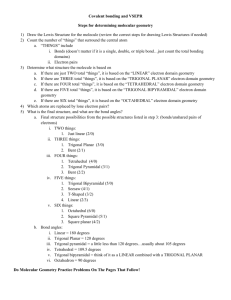
![Which is the correct Lewis structure for the nitrate ion, [NO3]– ? a) b](http://s3.studylib.net/store/data/008121614_1-3f41411d21eef682c95d3c7778684719-300x300.png)
